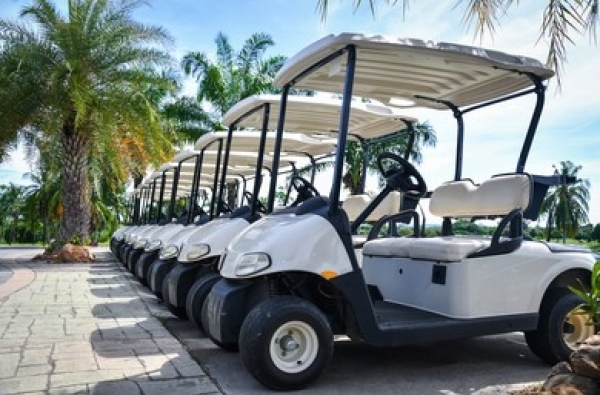Golf Cart Running Slow? 5 Common Reasons Why
What could be worse than pressing the gas pedal and getting a delayed response? Your golf cart may lose power and begin to operate slowly over time. This condition may not be pleasant, but it is one that can be improved.
There is no statewide legal maximum speed limit for golf carts. Instead, drivers must adhere to the speed restrictions and driving laws of the state and municipality in which they reside. The state driving handbook specifies where the cart may travel, who can drive it, and how fast it can go.
The five most typical causes for your golf cart’s slowness are as follows.
1. Speed Sensor Problems
The speed sensor is a vital component of golf cart functioning that ensures the cart works smoothly and effectively. It works by detecting how fast you are driving and calculating how much power is required to sustain that pace. When the speed sensor malfunctions, your cart will most likely operate slowly.
There are a few possible causes for this issue.
If the speed sensor fails, your cart may incorrectly interpret your speed and believe you are traveling slower. As a result, it will deliver less power to your engine, causing it to create less speed and causing accelerator troubles in the golf cart.
In another scenario, your speed sensor might fail. In this instance, your cart will be delayed at random moments.
How to Repair a Slow Golf Cart
- Inspect the Speed Magnet: If the speed magnet in your sensor fails, your cart will struggle to maintain its speed and will most likely not only slow down but even stop entirely.
- Examine Mud and Dirt Build-up: Although the speed sensor is a tough element that can survive some wear and tear, there’s a strong possibility your cart may slow down due to dirt or mud build-up.
- Inspect Wire Issues: If the wire on your speed sensor begins to deteriorate, your cart will likely slow down. Inspect the speed sensor wires to ensure they are fully operational.
- Age-Related Issues: Over time, your speed sensor may wear out and stop working as well as it once did.
These speed sensor repairs and replacements are quite straightforward, but we always suggest working with a professional to guarantee a seamless process.
2. Low battery power
The most prevalent cause of golf carts slowing down is a lack of power output from the battery. If your cart’s battery pack charge is extremely low and it is out of power, it will operate slowly.
If your cart is completely charged and has no other difficulties, the voltage output might be the issue.
Diagnosis of a Low Battery
Here’s how to go about it.
- Connect a digital voltmeter to your battery pack and examine the connections.
- Get inside your cart and start it. Someone may be required to hold the voltmeter attached to your battery.
- Keep your cart in neutral and use the pedal to prevent driving anybody over. Examine the voltmeter to discover how much electricity it generates. You should obtain a measurement of 36-48 volts based on your model.
- Examine the battery connections on the golf cart. If it doesn’t provide this much power, it means the battery isn’t working correctly.
- Determine the overall battery capacity. If your battery charge is low or non-existent, you will most likely need to charge it in order for it to function correctly.
- Recharge the battery and perform the test again. This time, if your battery is robust, you will get the bare minimum of charge.
- If the voltage output remains low, consider changing the battery.
When you change the batteries, they should resume normal operation and not lose speed while driving. If your carts continue to run slowly while you drive, there is likely a problem other than a dead battery.
You Can Read Also : Popular Aftermarket Parts & Accessories for a Golf Cart
3. Problems with the Forward/Reverse Switch
If your golf cart is going slowly, examine the forward/reverse switch. If this switch fails, your cart may move slowly because it is unsure which way you want it to travel. The forward/reverse switch is prone to sparking and malfunctioning due to wire breakdown.
Solution
A faulty forward/reverse switch should be replaced in most cases. Most cart owners, however, should be able to gently remove and replace the switch.
4. Bearing Encoder Problems
The bearing encoder is an important component of your golf cart that ensures proper electrical charge distribution throughout the cart. It works by encoding distinct aspects of your cart’s functionality and converting them to different impulses to keep the power flowing smoothly.
Does your cart start off OK at an average pace before slowing down as you drive? When your cart begins to slow down, do you notice it is in an uneven position? If it occurs, it is likely that the bearing encoder is failing, and the problem must be remedied as soon as possible.
Solution
The bearing encoder is a complex element, therefore we recommend enlisting the assistance of a professional. A professional can carefully balance your cart operation and the bearing encoder problem.
5 Ampacity Controller
The Ampacity controller is a component of your cart that aids in the management of the amperage produced and consumed while your cart runs. When this specific component fails, you’ll have certain problems with your cart’s functionality.
Ampacity controller errors include slowing, unexpected increases in speed, and other issues.
This problem usually occurs when the controller is not properly fitted. Consult a specialist to guarantee that you do not encounter any issues. Sometimes repair technicians may utilize aftermarket pieces that do not fit correctly on your ampacity controller, causing it to perform badly or fail, leaving you with a sluggish cart.



